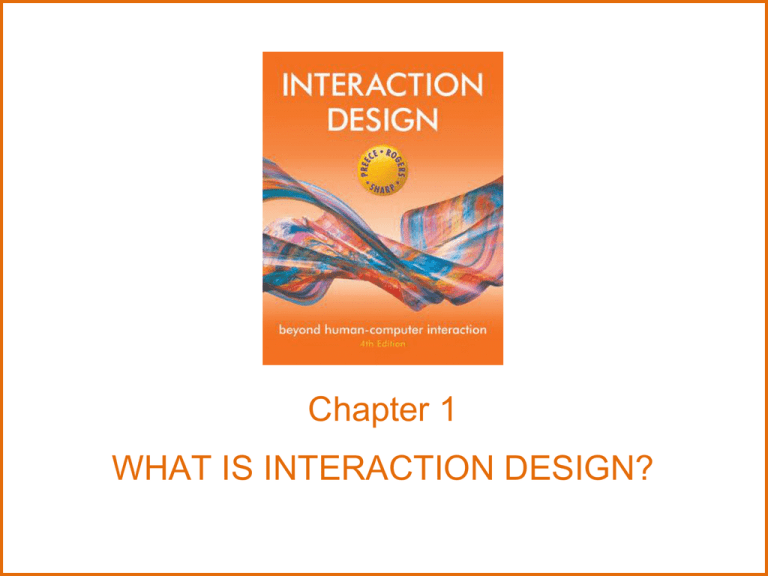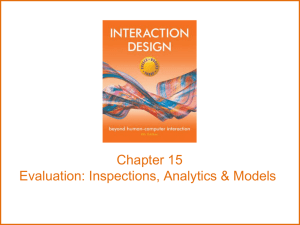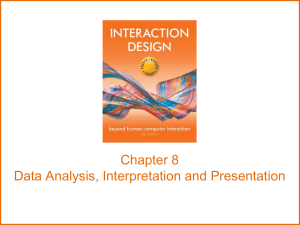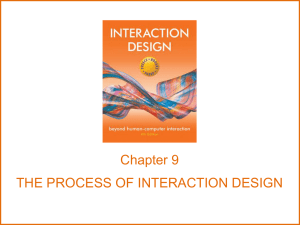Chapter 1 WHAT IS INTERACTION DESIGN?
advertisement

Chapter 1 WHAT IS INTERACTION DESIGN? Bad designs Elevator controls and labels on the bottom row all look the same, so it is easy to push a label by mistake instead of a control button www.baddesigns.com People do not make same mistake for the labels and buttons on the top row. Why not? www.id-book.com 2 Why is this vending machine so bad? • Need to push button first to activate reader • Normally insert bill first before making selection www.baddesigns.com • Contravenes well known convention www.id-book.com 3 Good design • Marble answering machine (Bishop, 1995) • Based on how everyday objects behave • Easy, intuitive and a pleasure to use • Only requires one-step actions to perform core tasks www.id-book.com 4 Good and bad design • Why is the TiVo remote so much better designed than standard remote controls? – Peanut shaped to fit in hand – Logical layout and color-coded, distinctive buttons – Easy to locate buttons See: http://gizmodo.com/5017972/story-of-a-peanut-the-tivo-remotesuntold-past-present-and-future www.id-book.com 5 Dilemma Which is the best way to interact with a smart TV? • Standard remote device? • Apple slimline remote control? • Minnum’s new keyboard? http://minuum.com www.id-book.com 6 What to design • Need to take into account: – Who the users are – What activities are being carried out – Where the interaction is taking place • Need to optimize the interactions users have with a product: – So that they match the users’ activities and needs www.id-book.com 7 Understanding users’ needs – Need to take into account what people are good and bad at – Consider what might help people in the way they currently do things – Think through what might provide quality user experiences – Listen to what people want and get them involved – Use tried and tested user-centered methods www.id-book.com 8 What is interaction design? • “Designing interactive products to support the way people communicate and interact in their everyday and working lives.” – Preece, Sharp and Rogers (2015) • “The design of spaces for human communication and interaction.” – Winograd (1997) www.id-book.com 9 Goals of interaction design • Develop usable products – Usability means easy to learn, effective to use and provide an enjoyable experience – But what about P24? • Involve users in the design process www.id-book.com 10 Which kind of design? • Number of other terms used emphasizing what is being designed, e.g. – user interface design, software design, user-centered design, product design, web design, experience design (UX) • Interaction design is the umbrella term covering all of these aspects – fundamental to all disciplines, fields, and approaches concerned with researching and designing computer-based systems for people www.id-book.com 11 HCI and interaction design www.id-book.com 12 Relationship between ID, HCI and other fields Academic disciplines contributing to ID: – Psychology – Social Sciences – Computing Sciences – Engineering – Ergonomics – Informatics www.id-book.com 13 Relationship between ID, HCI and other fields Design practices contributing to ID: – Graphic design – Product design – Artist-design – Industrial design – Film industry www.id-book.com 14 Relationship between ID, HCI and other fields Interdisciplinary fields that ‘do’ interaction design: – – – – – – – HCI Ubiquitous Computing Human Factors Cognitive Engineering Cognitive Ergonomics Computer Supported Co-operative Work Information Systems www.id-book.com 15 Working in multidisciplinary teams • Many people from different backgrounds involved • Different perspectives and ways of seeing and talking about things • Benefits – more ideas and designs generated • Disadvantages – difficult to communicate and progress forward the designs being create www.id-book.com 16 XXXInteraction design in business • Increasing number of ID consultancies, examples of well known ones include: – Nielsen Norman Group: “help companies enter the age of the consumer, designing human-centered products and services” – Cooper: “From research and product to goal-related design” – Swim: “provides a wide range of design services, in each case targeted to address the product development needs at hand” – IDEO: “creates products, services and environments for companies pioneering new ways to provide value to their customers” www.id-book.com 17 What do professionals do in the ID business? • interaction designers - people involved in the design of all the interactive aspects of a product • usability engineers - people who focus on evaluating products, using usability methods and principles • web designers - people who develop and create the visual design of websites, such as layouts • information architects - people who come up with ideas of how to plan and structure interactive products • user experience designers (UX) - people who do all the above but who may also carry out field studies to inform the design of products www.id-book.com 18 The User Experience • How a product behaves and is used by people in the real world – the way people feel about it and their pleasure and satisfaction when using it, looking at it, holding it, and opening or closing it – “every product that is used by someone has a user experience: newspapers, ketchup bottles, reclining armchairs, cardigan sweaters.” (Garrett, 2010) – “all aspects of the end-user's interaction with the company, its services, and its products. (Nielsen and Norman, 2014) • Cannot design a user experience, only design for a user experience www.id-book.com 19 Why was the iPod user experience such a success? • Quality user experience from the start • Simple, elegant, distinct brand, pleasurable, must have fashion item, catchy names, cool, etc. www.id-book.com 20 What is involved in the process of interaction design • Establishing requirements • Developing alternatives • Prototyping • Evaluating www.id-book.com 21 Core characteristics of interaction design • Users should be involved through the development of the project • Specific usability and user experience goals need to be identified, clearly documented and agreed at the beginning of the project • Iteration is needed through the core activities www.id-book.com 22 Why go to this length? • Help designers: – understand how to design interactive products that fit with what people want, need and may desire – appreciate that one size does not fit all e.g., teenagers are very different to grown-ups – identify any incorrect assumptions they may have about particular user groups e.g., not all old people want or need big fonts – be aware of both people’s sensitivities and their capabilities www.id-book.com 23 Are cultural differences important? • Which should be used for international services and online forms? • 5/21/2015 versus 21/5/2015? • Even more difficult: – 07/08/15 or 08/07/15? • Why is it that certain products, like the iPod, are universally accepted by people from all parts of the world whereas websites are reacted to differently by people from different cultures? www.id-book.com 24 Accessibility • Degree to which a product is usable and accessible by as many people as possible • Focus on disability: – Have a mental or physical impairment – This has an adverse affect on their everyday lives – It is long term www.id-book.com 25 Anna, IKEA online sales agent • Designed to be different for UK and US customers • What are the differences and which is which? • What should Anna’s appearance be like for other countries, like India, South Africa, or China? www.id-book.com 26 Usability goals • Effective to use • Efficient to use • Safe to use • Have good utility • Easy to learn • Easy to remember how to use www.id-book.com 27 User experience goals Desirable aspects satisfying enjoyable engaging pleasurable exciting entertaining helpful motivating challenging enhancing sociability supporting creativity cognitively stimulating Undesirable aspects boring frustrating making one feel guilty annoying childish unpleasant patronizing making one feel stupid cutesy gimmicky www.id-book.com fun provocative surprising rewarding emotionally fulfilling 28 Usability and user experience goals • Selecting terms to convey a person’s feelings, emotions, etc., can help designers understand the multifaceted nature of the user experience • How do usability goals differ from user experience goals? • Are there trade-offs between the two kinds of goals? – e.g. can a product be both fun and safe? • How easy is it to measure usability versus user experience goals? www.id-book.com 29 Design principles • Generalizable abstractions for thinking about different aspects of design • The do’s and don'ts of interaction design • What to provide and what not to provide at the interface • Derived from a mix of theory-based knowledge, experience and common-sense www.id-book.com 30 Design principles • • • • • Visibility Feedback Constraints Consistency Affordance www.id-book.com 31 Visibility • This is a control panel for an elevator • How does it work? • Push a button for the floor you want? • Nothing happens. Push any other button? Still nothing. What do you need to do? www.baddesigns.com • It is not visible as to what to do! www.id-book.com 32 Visibility …you need to insert your room card in the slot by the buttons to get the elevator to work! How would you make this action more visible? • make the card reader more obvious • provide an auditory message, that says what to do (which language?) • provide a big label next to the card reader that flashes when someone enters • make relevant parts visible www.baddesigns.com • make what has to be done obvious www.id-book.com 33 What do I do if I am wearing black? Invisible automatic controls can make it more difficult to use www.id-book.com 34 Feedback • Sending information back to the user about what has been done • Includes sound, highlighting, animation and combinations of these – e.g. when screen button clicked on provides sound or red highlight feedback: “ccclichhk” www.id-book.com 35 Constraints • Restricting the possible actions that can be performed • Helps prevent user from selecting incorrect options • Physical objects can be designed to constrain things – e.g. only one way you can insert a key into a lock www.id-book.com 36 Logical or ambiguous design? • Where do you plug the mouse? • Where do you plug the keyboard? • top or bottom connector? • Do the color coded icons help? www.baddesigns.com www.id-book.com 37 How to design them more logically (i) A provides direct adjacent mapping between icon and connector www.baddesigns.com (ii) B provides color coding to associate the connectors with the labels www.baddesigns.com www.id-book.com 38 Consistency • Design interfaces to have similar operations and use similar elements for similar tasks • For example: – always use ctrl key plus first initial of the command for an operation – ctrl+C, ctrl+S, ctrl+O • Main benefit is consistent interfaces are easier to learn and use www.id-book.com 39 When consistency breaks down • What happens if there is more than one command starting with the same letter? – e.g. save, spelling, select, style • Have to find other initials or combinations of keys, thereby breaking the consistency rule – e.g. ctrl+S, ctrl+Sp, ctrl+shift+L • Increases learning burden on user, making them more prone to errors www.id-book.com 40 Internal and external consistency • Internal consistency refers to designing operations to behave the same within an application – Difficult to achieve with complex interfaces • External consistency refers to designing operations, interfaces, etc., to be the same across applications and devices – Very rarely the case, based on different designer’s preference www.id-book.com 41 Keypad numbers layout • A case of external inconsistency (a) phones, remote controls (b) calculators, computer keypads 1 4 2 3 5 6 7 8 9 4 5 6 7 8 1 0 2 3 9 0 www.id-book.com 42 Affordances: to give a clue • Refers to an attribute of an object that allows people to know how to use it – e.g. a mouse button invites pushing, a door handle affords pulling • Norman (1988) used the term to discuss the design of everyday objects • Since has been much popularised in interaction design to discuss how to design interface objects – e.g. scrollbars to afford moving up and down, icons to afford clicking on www.id-book.com 43 What does ‘affordance’ have to offer interaction design? • Interfaces are virtual and do not have affordances like physical objects • Norman argues it does not make sense to talk about interfaces in terms of ‘real’ affordances • Instead interfaces are better conceptualized as ‘perceived’ affordances – Learned conventions of arbitrary mappings between action and effect at the interface – Some mappings are better than others www.id-book.com 44 Activity – Virtual affordances How do the following screen objects afford? What if you were a novice user? Would you know what to do with them? www.id-book.com 45 Key points • Interaction design is concerned with designing interactive products to support the way people communicate and interact in their everyday and working lives • It is concerned with how to create quality user experiences • It requires taking into account a number of interdependent factors, including context of use, type of activities, cultural differences, and user groups • It is multidisciplinary, involving many inputs from widereaching disciplines and fields www.id-book.com 46







